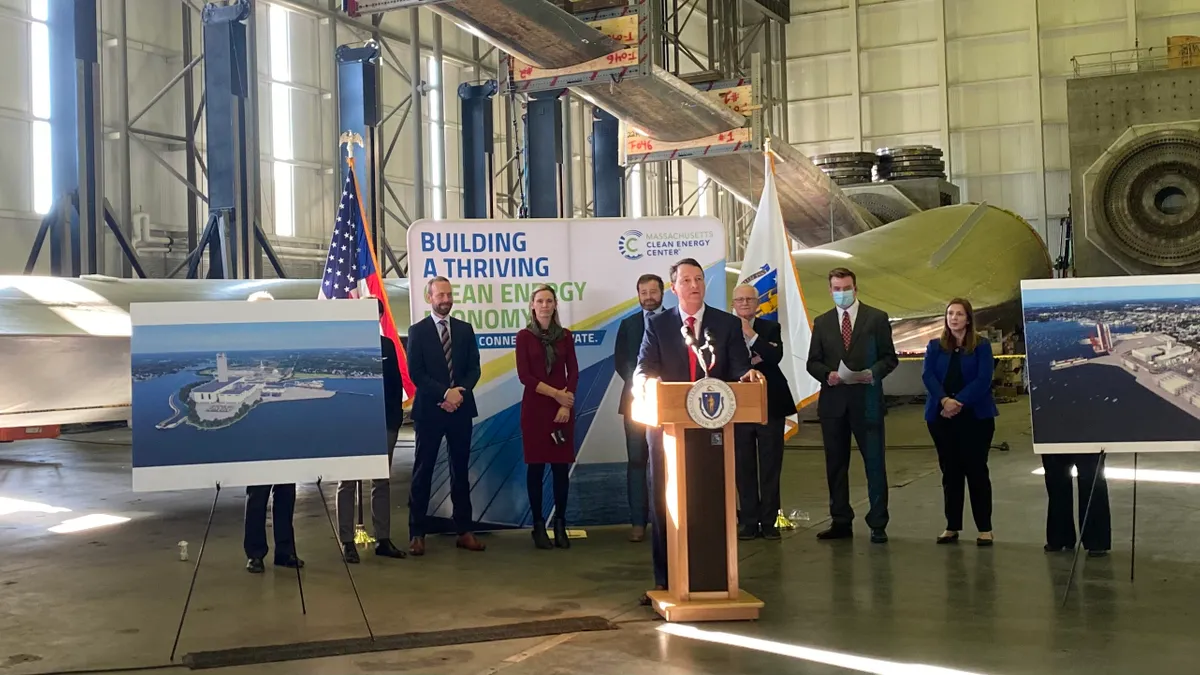Dive Brief:
- Massachusetts on Friday announced the selection of two offshore wind projects totaling 1,600 MW of new capacity, bringing the state to 3,200 MW of a 5,600 MW offshore wind procurement goal by 2027.
- The state's third offshore wind procurement awarded two developers that are already working on large-scale projects in the area, Vineyard Wind and Mayflower Wind, doubling the amount of offshore wind secured by the state.
- As of Friday, U.S. states have procured over 17,100 MW of offshore wind, nearly double the January total of 9,100 MW, according to the Business Network for Offshore Wind.
Dive Insight:
East Coast states are advancing on their ambitious renewable energy goals through solicitations to increase their offshore wind capacity. Also on Friday, Maryland regulators awarded offtake agreements to U.S. Wind and to Skipjack Offshore Energy for a combined 1,654.5 MW, securing 2,022 MW of offshore wind capacity for the state.
The state's Clean Energy Jobs Act of 2019 expanded capacity for offshore wind in its Renewable Energy Portfolio to at least 1,200 MW. The Maryland Public Service Commission also closed the next anticipated application periods for offshore wind solicitations, noting in a press statement that the latest approved bids "will not leave any room for additional projects."
US Wind and Skipjack submitted multiple bids. Maryland regulators awarded offshore wind renewable energy credits for 808.5 MW to US Wind's Momentum Wind development, at a levelized price of $54.17/MWh for 20 years. Ørsted Offshore North America's Skipjack was awarded 846 MW of credits at $71.61/MWh for 20 years. Both projects are subject to review from the U.S. Bureau of Ocean Energy Management, and are expected to be operational before the end of 2026.
Maryland's offshore offtake agreements also stipulate that the developers invest in three major component manufacturing facilities for the industry: monopiles, turbine towers and array cables. Those agreements serve to develop the U.S. offshore wind supply chain, "transforming Baltimore Harbor into a hive of activity as steel components are shipped to offshore wind facilities along the East Coast," Liz Burdock, CEO and president of the Business Network for Offshore Wind, said in a statement.
Massachusetts is also aiming to build up the supply chain, drawing investments to ports in Salem and Falls River, and supporting the construction of a cable facility at Brayton Point, through the latest contracts.
"Offshore wind is the centerpiece of Massachusetts' climate goals and our effort to achieve Net Zero emissions in 2050, and this successful procurement will build on our national clean energy leadership and the continued development of a robust offshore wind supply chain in the Commonwealth," Kathleen Theoharides, secretary of the state's Executive Office of Energy and Environmental Affairs, said in a statement.
Vineyard, a joint venture of Copenhagen Infrastructure Partners and Avangrid Renewables, received a 1,200 MW contract, in addition to its previous 800 MW contract.
"This is more than just one project, it is part of an effort to build a clean energy infrastructure including the transformation of ports around our state as well as jobs and training that will support this clean energy industry for decades to come," President and CEO of Avangrid Renewables Offshore Bill White said in a statement.
Separately, Mayflower, owned by Royal Dutch Shell and a joint venture of EDP Renewables and ENGIE, received a 400 MW contract, in addition to its first 800 MW project for the state.
"Having multiple selections helps with building out the workforce, helps with building out the industry, the supply chain ... showing an investment in Massachusetts," said Daniel Hubbard, Mayflower's director of external affairs and general counsel.
The developers approved by Massachusetts already had approval from BOEM to build out their lease areas. The full capacity of Mayflower's lease is 2,000 MW, of which only 1,200 MW is currently contracted.
The company has secured an interconnection for 1,200 MW at Brayton Point, "where it was formally coal coming in," and has made progress on its interconnection plans with the region's grid operator. "We're ahead of the game," Hubbard said.
CORRECTION: A previous version of this article misidentified the owners of Mayflower Wind.














